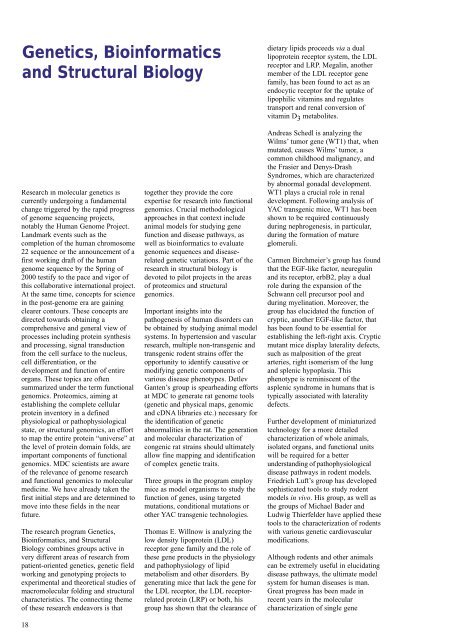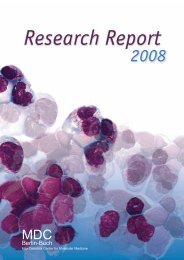Create successful ePaper yourself
Turn your PDF publications into a flip-book with our unique Google optimized e-Paper software.
Genetics, Bioinformatics<br />
and Structural Biology<br />
<strong>Research</strong> in molecular genetics is<br />
currently undergoing a fundamental<br />
change triggered by the rapid progress<br />
of genome sequencing projects,<br />
notably the Human Genome Project.<br />
Landmark events such as the<br />
completion of the human chromosome<br />
22 sequence or the announcement of a<br />
first working draft of the human<br />
genome sequence by the Spring of<br />
<strong>2000</strong> testify to the pace and vigor of<br />
this collaborative international project.<br />
At the same time, concepts for science<br />
in the post-genome era are gaining<br />
clearer contours. These concepts are<br />
directed towards obtaining a<br />
comprehensive and general view of<br />
processes including protein synthesis<br />
and processing, signal transduction<br />
from the cell surface to the nucleus,<br />
cell differentiation, or the<br />
development and function of entire<br />
organs. These topics are often<br />
summarized under the term functional<br />
genomics. Proteomics, aiming at<br />
establishing the complete cellular<br />
protein inventory in a defined<br />
physiological or pathophysiological<br />
state, or structural genomics, an effort<br />
to map the entire protein “universe” at<br />
the level of protein domain folds, are<br />
important components of functional<br />
genomics. <strong>MDC</strong> scientists are aware<br />
of the relevance of genome research<br />
and functional genomics to molecular<br />
medicine. We have already taken the<br />
first initial steps and are determined to<br />
move into these fields in the near<br />
future.<br />
The research program Genetics,<br />
Bioinformatics, and Structural<br />
Biology combines groups active in<br />
very different areas of research from<br />
patient-oriented genetics, genetic field<br />
working and genotyping projects to<br />
experimental and theoretical studies of<br />
macromolecular folding and structural<br />
characteristics. The connecting theme<br />
of these research endeavors is that<br />
18<br />
together they provide the core<br />
expertise for research into functional<br />
genomics. Crucial methodological<br />
approaches in that context include<br />
animal models for studying gene<br />
function and disease pathways, as<br />
well as bioinformatics to evaluate<br />
genomic sequences and diseaserelated<br />
genetic variations. Part of the<br />
research in structural biology is<br />
devoted to pilot projects in the areas<br />
of proteomics and structural<br />
genomics.<br />
Important insights into the<br />
pathogenesis of human disorders can<br />
be obtained by studying animal model<br />
systems. In hypertension and vascular<br />
research, multiple non-transgenic and<br />
transgenic rodent strains offer the<br />
opportunity to identify causative or<br />
modifying genetic components of<br />
various disease phenotypes. Detlev<br />
Ganten’s group is spearheading efforts<br />
at <strong>MDC</strong> to generate rat genome tools<br />
(genetic and physical maps, genomic<br />
and cDNA libraries etc.) necessary for<br />
the identification of genetic<br />
abnormalities in the rat. The generation<br />
and molecular characterization of<br />
congenic rat strains should ultimately<br />
allow fine mapping and identification<br />
of complex genetic traits.<br />
Three groups in the program employ<br />
mice as model organisms to study the<br />
function of genes, using targeted<br />
mutations, conditional mutations or<br />
other YAC transgenic technologies.<br />
Thomas E. Willnow is analyzing the<br />
low density lipoprotein (LDL)<br />
receptor gene family and the role of<br />
these gene products in the physiology<br />
and pathophysiology of lipid<br />
metabolism and other disorders. By<br />
generating mice that lack the gene for<br />
the LDL receptor, the LDL receptorrelated<br />
protein (LRP) or both, his<br />
group has shown that the clearance of<br />
dietary lipids proceeds via a dual<br />
lipoprotein receptor system, the LDL<br />
receptor and LRP. Megalin, another<br />
member of the LDL receptor gene<br />
family, has been found to act as an<br />
endocytic receptor for the uptake of<br />
lipophilic vitamins and regulates<br />
transport and renal conversion of<br />
vitamin D 3 metabolites.<br />
Andreas Schedl is analyzing the<br />
Wilms’ tumor gene (WT1) that, when<br />
mutated, causes Wilms’ tumor, a<br />
common childhood malignancy, and<br />
the Frasier and Denys-Drash<br />
Syndromes, which are characterized<br />
by abnormal gonadal development.<br />
WT1 plays a crucial role in renal<br />
development. Following analysis of<br />
YAC transgenic mice, WT1 has been<br />
shown to be required continuously<br />
during nephrogenesis, in particular,<br />
during the formation of mature<br />
glomeruli.<br />
Carmen Birchmeier’s group has found<br />
that the EGF-like factor, neuregulin<br />
and its receptor, erbB2, play a dual<br />
role during the expansion of the<br />
Schwann cell precursor pool and<br />
during myelination. Moreover, the<br />
group has elucidated the function of<br />
cryptic, another EGF-like factor, that<br />
has been found to be essential for<br />
establishing the left-right axis. Cryptic<br />
mutant mice display laterality defects,<br />
such as malposition of the great<br />
arteries, right isomerism of the lung<br />
and splenic hypoplasia. This<br />
phenotype is reminiscent of the<br />
asplenic syndrome in humans that is<br />
typically associated with laterality<br />
defects.<br />
Further development of miniaturized<br />
technology for a more detailed<br />
characterization of whole animals,<br />
isolated organs, and functional units<br />
will be required for a better<br />
understanding of pathophysiological<br />
disease pathways in rodent models.<br />
Friedrich Luft’s group has developed<br />
sophisticated tools to study rodent<br />
models in vivo. His group, as well as<br />
the groups of Michael Bader and<br />
Ludwig Thierfelder have applied these<br />
tools to the characterization of rodents<br />
with various genetic cardiovascular<br />
modifications.<br />
Although rodents and other animals<br />
can be extremely useful in elucidating<br />
disease pathways, the ultimate model<br />
system for human diseases is man.<br />
Great progress has been made in<br />
recent years in the molecular<br />
characterization of single gene

















